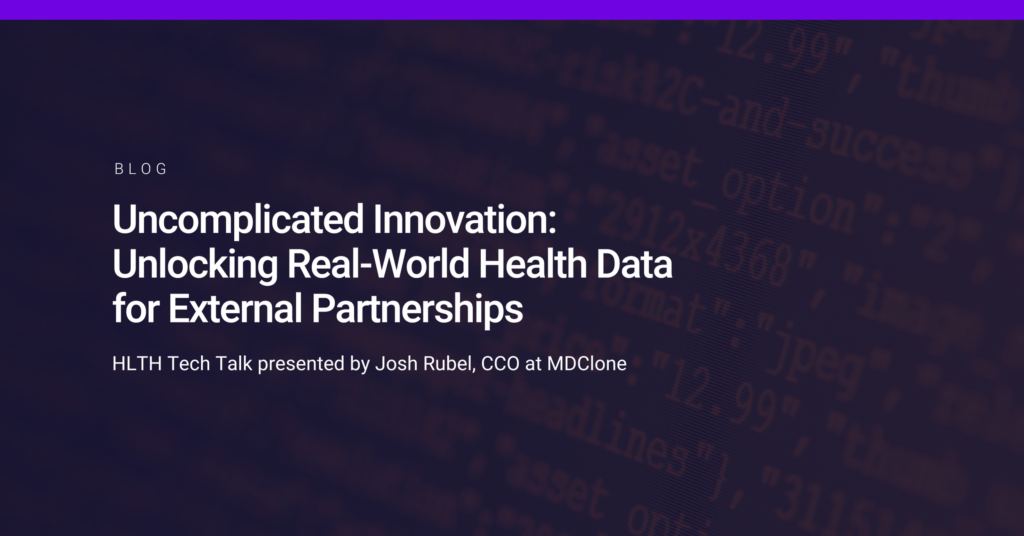There’s a novel concept that is starting to pick up steam across the healthcare industry. Innovation through collaboration is transforming healthcare.
-
So how do professionals unlock the real world data to support external partnerships?
-
How do health systems navigate their way through the challenges data sharing creates and become a magnet at the core of innovation?
Let’s start with what we currently have.
A Hub of Innovation
Today’s health systems typically have three established verticals where innovation can be discovered.
-
The providers who take care of patients
-
The facilities where the patient receives care
-
The data lake of information that has accrued from the care that is provided
Health information is the currency of healthcare. We know that from the President & CEO of the Joint Commission Dr. Jonathan Perlin.
If a health system is going to be a true hub of innovation, making use of data is a must.
The Innovative Health System
A true innovative health system is operating on four pillars.
-
It’s one that is trying to improve quality through continuous learning.
-
It’s one that supports its workforce to maintain the joy of practice, and to be prepared for future care of delivery.
-
It’s one that develops the next breakthroughs – generating new revenue and improved outcomes in parallel.
-
It’s one that collaborates with peers and industry leaders to efficiently learn, improve, and share findings to transform healthcare for tomorrow.
To check all four boxes of operation may seem daunting, but fortunately we have several health systems across the globe who are doing this sort of work. Places like Ochsner Health System, Sheba Medical Center, Intermountain Healthcare, and the US Department of Veterans Affairs (VHA) are a few examples of systems who are all building a growing designer around data – collaborating and creating positive outcomes.
What Does Success Look Like?
Each of the systems mentioned above are leveraging innovation as a term of success which can look differently for each organization.
Sometimes, success is leveraging resources that may not work for a health system today, but improving how that health system operates overall, investing in staff, continuous learning, etc. Other times, it means creating additional revenue streams and acting on top-line revenue opportunities to fuel innovation. Success is taking the next step to utilize breakthrough technology and taking advantage of the benefits new technology can provide in relation to IP.
This seems easy enough. So why isn’t this ideal of being a global network of innovation exploding across the industry?
The Compounding Challenges
Becoming a true innovative health system is not out of reach. Any organization on planet Earth could become a magnet for innovation to take place. But right now, there are challenges teams have to jump through.
-
Patient Privacy
-
Data Complexity
-
Multiple Staff
-
And more
It’s a bit of a maze to get data out of a health system, even when you are in the health system itself, to get project work done and reach the end results. But when you add the complexity of accessing that data when you are outside of the health system, it becomes even more complicated.
The internal review board (IRB) process associated with data access for a third party is not measured in days. A process today can take months which is an extremely long cycle of time.
To explore the data, third parties have to wait for the PI/Analyst assignment within the health system and the data to be identified before sending it to the IRB. After the approval, a request is sent, provisioning and authentication are done before sending to an SQL coder. These coders are truly the only ones who can interrogate the health system’s data.
For the past 30 years, this process has not changed. Once data has entered an EHR and if a professional has a question about that data, a ticket has to be submitted for another person to put you in their queue. When you get the results, it may not be what you were expecting or what you wanted in the first place. Now, you are three months (or more) behind on getting answers to an idea that can be improving patient outcomes.
The Solution to RWE Data Exploration
-
What if, with technology and services, you could open your health system environment without any risk to patient privacy or any exploration morass?
-
What if people without SQL programming knowledge could interrogate data and ask questions of data around a care process or outcome on their own?
This creates an opportunity for innovation at any health system, most importantly with third parties. Without the risk of exposing patient information, we can open up the force multiplication that comes from third party organizations.
MDClone is set up to provide this infrastructure that, on one side, reduces the data complexity that requires months for someone to provide a dashboard for exploration. On the other side, all of the output generated through our platform can be used externally through a synthetic data format. This means that there is no human subject data in the output, but it tells the same story. In fact, it tells an identical story as the original data would have told.
Now, health systems can make their data available to third parties and they can interrogate the information as part of a joint venture with the health system at the core.
How Does It Work?
If you’re a health system, you’ve got a variety of data: claims, EHR, lab, etc. This is all stored behind a firewall that you – as a health system – can unlock on a project-by-project basis. With MDClone, you also are also given the opportunity to unlock the data through a subscription basis where a life science brand can subscribe to your health system and access real world data for projects that you, health system, get to approve.
This collaboration isn’t working through a large-scale aggregation cloud in the sky. This is a collaboration that is putting health systems at the center of innovation to enable the use of real world data.
To learn more about unlocking real-word health data for external partnerships, connect with us here.
Who Is Using This Model?
Sheba Medical Center: 15+ Life Science Engagements, Numerous Academic Partners, 20+ Technology Partners
Washington University in St. Louis & The Ottawa Hospital: Cross-institutional Research and International Collaboration
VHA Innovation Ecosystem: Mission Daybreak Research, CHF Readmission Predictions, ATTR – a model in 10 days
Learn more about MDClone’s Life Sciences Platform → The Platform for Life Sciences













